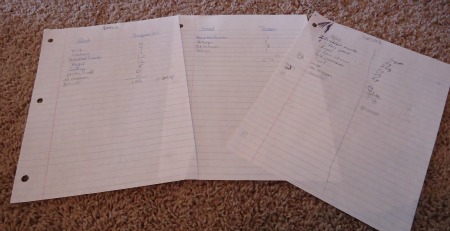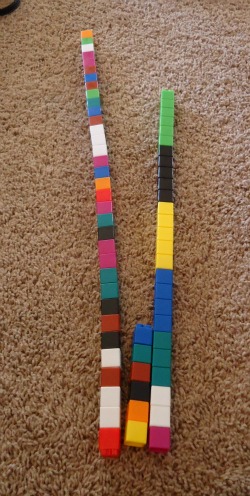The following is a post from contributing writer Marci.
photo credit: M I S C H E L L E
We’ve been studying nutrition at our house this past month. The kids learned to determine how much of each food group they need to eat at a meal in order to be healthy. We used the new My Plate USDA guidelines.
My seven year old son was quick to point out that the My Plate guidelines left out his favorite food group – sugar. And since it’s the holiday season, his sweet tooth is on high alert!
This lack of sugar in the recommended daily diet caused us to do some research. Are there any dietary guidelines for sugar? We all know too much sugar isn’t good for us, but…
Just how much sugar is too much?
The average American consumes 22 teaspoons of sugar per day. What?! This is well above the American Heart Association’s recommendation of no more than 6 to 9 teaspoons of sugar daily. That’s a pretty large gap between what is acceptable and what is the norm.
This made us wonder…How much sugar are we consuming?
I really had no idea. I am known as the “food nazi” around here and don’t buy a lot of sugary or processed food. Even at that, I had a suspicion that my sweet-loving kids were still getting way more sugar than they needed.
Keeping Track of Sugar Consumption
The kids and I decided to keep track of sugar consumption for a day. We simply wrote down everything we ate or drank for an entire day. To determine how much sugar was in our foods we read labels, used an online nutrition tracker such as the Food-O-Meter from WebMD.com, an app like My Fitness Pal, or we just Googled it.
Using labels and nutrition trackers, we figured out grams of sugar consumed. Then, we converted grams into teaspoons. A teaspoon of sugar is 4 grams. So, for instance, if the food contained 16 grams of sugar, we divided 16 by 4 and that’s the teaspoons of sugar — 4.
Our results shocked me. Even with a “food nazi” for a mother, my kids still managed to take in way more sugar than recommended. The culprits?
For my daughter, it was the juice she likes in the morning (25 grams per1 cup) and the sweet bread she loves to eat with sandwiches (10 grams of sugar per roll – she ate 3). That right there was almost 14 tsp of sugar!
For my son, the high sugar culprits were the ovaltine in milk (21 grams of sugar), jelly (12 grams of sugar) and the same sweet bread (10 grams of sugar).
Then, to top the day off, someone bought the kids 2 scoops of ice cream each at a local ice cream shop. Get this —> 51 grams of sugar in those 2 scoops!!! That’s 13 teaspoons of sugar!!
My sugar intake for the day? Just under 3 teaspoons. yes!
Assuming the kids should get less than the 6 gram recommended upper limit of sugar that women should get, they went way over. I was horrified. The kids were not phased by the numbers.
Making it real
I needed to do something hands-on to get the kids to realize just how much sugar they are consuming. Inspired by SugarStacks.com, I decided we would create our own “sugar” stacks to see just how much sugar we actually ate. Instead of using sugar cubes (I couldn’t find any), we used unifix cubes. One cube = one teaspoon of sugar.
See the little stack of six in the middle? That supposed to be our upper dietary recommendation for sugar consumption. See those huge stacks on each side? Yeah. That how much my kids ate in one day.
Why is too much sugar bad for us?
While our bodies need sugar for energy, studies have shown that too much sugar is not good for our health. From increasing the risk of diabetes, to decreasing cardiovascular health, to the negative effects of sugar on our brains , the effects of excess sugar consumption can be frightening.
This little exercise made us realize that sugar isn’t just in candy and cookies. It’s in lots of other foods we consume everyday – even foods we think of as “healthy.”
Will this study change my kids eating habits? Maybe a little. My daughter voluntarily gave up her morning juice and decided that the sweet bread should be just for special occasions. That’s a good start. My son…he’s seven and just wants his ovaltine!!
Will I keep my family from enjoying the sweet pleasures of the season? No. However, I will be watching our sugar from other sources to try and keep it under control. I’m the mom. It’s my job to keep them healthy and teach them how to do the same.
How much sugar do you and your kids consume? Try this simple project and find out!
More Homeschool Science Activities on Pinterest






Keri says
We recently did this too! I was amazed to see how much sugar my kids were getting, even while I was making mostly healthy, natural foods. We tracked ours for a week and to visualize, poured granulated sugar in a measuring cup. We have changed our routine slightly, but it is hard to get a 6-year-old to give up his PBJ!
Marci@TheHomeschoolScientist says
My 7 year old doesn’t seem to care how much sugar he eats either, so I have to cut the sugar where I can without him realizing it and letting him have a few of his sugary faves 🙂
Jessica says
I think it’s so interesting what we consider “processed”. Really, almost everything we eat is processed in some way. It is interesting that we consider things like juice, condiments, items that are whole grain, etc, as not processed. Anything canned, frozen, or baked has been processed in some way. I guess I understand what people mean when they speak that way, but I think we need a new term for things in a box that aren’t good for us. 🙂 It is eye opening when we really pay attention to what we eat. Really, we just do the best we can with the resources God’s given to us, attempting to not food rule in our hearts where God should be.
Paige says
Great article and a good reminder, but it is so hard to keep sugar consumption under control during the holidays!
Marci@TheHomeschoolScientist says
The holidays are not the best time to start watching the sugar intake. I agree. lol! It’s kind of torture! However, it can be the right time of year to become aware of what we are actually eating so that we can make some changes after the holidays.
Taylor says
Great post and so needed. Everybody needs to be more cognizant of their sugar intake. That SugarStacks.com is a pretty cool website too. I’ll check that out.
It is so great to visualize what different amounts of sugar really mean. It hits home. I love the building blocks. My mother in law used to be a practicing dietitian and she gave me all of her test tubes which break down the sugar content in many of the popular foods. It’s disgusting!